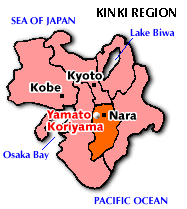

Nara is located in the Kinki region, along with Osaka and Kyoto, and is roughly in the center of Japan's main island, Honshu. The prefecture's northern region is relatively flat, while its southern district is quite hilly.
People have been living in the flatter areas since before the first century A.D., and many ancient relics have been discovered. There are more than a thousand burial mounds for local lords dating from the third to fifth century A.D. The Asuka district became the center of national government in the second half of the fifth century, and Heijokyo (present-day Nara City) replaced it as the seat of power for 70 years from 710. A number of temples built during that era, including Todaiji, can still be seen in roughly their original form.
The Yoshino mountain range in southern Nara extends 70 kilometers (43 miles) east-west and 80 kilometers (50 miles) north-south and occupies about two-thirds of the prefecture's land area. Three rivers--the Yoshino, Kitayama, and Totsu--run north to south between ridges rising 1,000 meters (3,300 feet) to 1,900 meters (6,200 feet) above sea level. Southern Nara is one of the rainiest regions in Japan and supplies drinking water for the Kinki district. The unspoiled natural terrain is home to native varieties of such large animals as deers and bears, and it's also the breeding ground for several rare bird species.